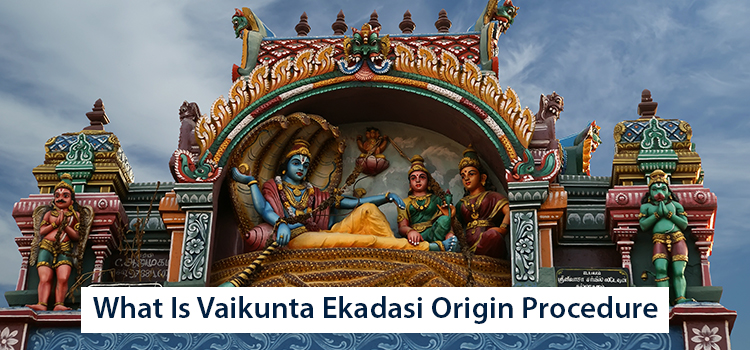Vaikunta Ekadasi/Vaikuntha Ekadashi is a significant event for Hindus, and especially for Vaishnavites, or those who are devotees of Lord Vishnu, the God of Preservation in Hindu theogony. For it is on this day that Vishnu opens the gateway to his heavenly abode, Vaikunta. According to mythology. Vishnu opened the gate for two demons who were actually his foes. They also wanted a boon from him, that those who listen to their story and see Vishnu’s image coming out of the door (called Vaikunth Dwar) will also enter Vaikunta. For this reason, temples throughout India create a door-like structure on this day for visitors to walk through.
Legend behind Vaikunta Ekadasi
The Padma Purana says that the female energy of Vishnu killed a demon called Muran and protected the gods from danger. This occurred on the 11th day of the lunar month during the Sun’s journey in Dhanu Rashi. Vishnu gave her the name, ‘Ekadashi’ and also the boon that people who worship ‘Ekadashi’ on the day she killed Muran would reach Vaikunta.
Vaikunta Ekadasi is a very auspicious day, and it is dedicated to Vishnu. It occurs in Margashirsha month (between December and January). Those who observe it can attain freedom from the cycle of birth and death.
Vaikunta Ekadasi Rituals
In India, Hindus observe important fasts or Vratas during the waning Moon period, called Krishna Paksha. For example, Vaikunta Ekadasi, Shashti (for Lord Muruga), Shivaratri, Ganesh Chaturthi, etc., are observed during this period. Vaikunta Ekadasi is celebrated grandly in major Vaishnava Temples like Srirangam and Srivilliputtur.
On Vaikunta Ekadasi, early in the morning, the doors that lead to the inner sanctum of Lord Vishnu at Vishnu temples are opened, and people enter through them. The temple priests perform special poojas for the occasion. On other days, the doors will be closed. On this day, devotees observe a vrat/ fast, so they do not consume anything. On the next day, which is Dwadasi, they drink Tulasi water to break the fast. Breaking the fast is Paranai, and this has to be done within Dwadasi Tithi unless Dwadasi gets over before sunrise.
After Paranai, people eat some simple food. This could be a raita made using Urad dal or Black Gram, and Agathi keerai, a kind of greens, as well as a salad of Amla or Gooseberries in curd.
Devotees eat food only once during the day. In the evening, devotees make offerings like fruits, flowers, Naivedya, vermilion, and turmeric to Vishnu. At night, a light snack made of rice is eaten. Nowadays, people often have some light snacks on Ekadasi day. But this should not be done.
On Ekadasi, devotees chant Vishnu mantras and take part in Poojas, Yagnas, and Homas at Vishnu temples. Some devotees even stay in the temple all through the day, chanting Vishnu’s names.
Origin of Ekadasi Vrat
The Vishnu Purana says that fasting on Vaikunta Ekadasi is equal to fasting on the remaining 23 Ekadasi days of the (Hindu) year. In Vaishnava tradition, it is mandatory to fast on all Ekadasis during Shukla paksha as well as Krishna paksha. Fasting on Ekadasi is one of the most holy things to do in Hinduism.
Significance of Vaikunta Ekadasi
It is said that Vaikunta is a place of abundance, where there is no lack or shortage, as it is Vishnu’s abode. In Hindi, kuntha means shortage. The Srimad Bhagawatam says that everyone who dwells in Vaikunta is Narayana, which means that every soul achieves a divine state in Vishnu’s abode and appears as Narayana/Vishnu. It is not possible to distinguish between the Lord and his devotee.


